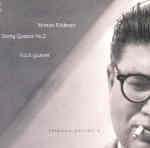First, let me address the two most obvious issues.
Question: Did you listen to all six hours of the bloody thing?
Answer: Yes.
Question: Did you do it all at one sitting?
Answer: Are you out of your mind?
Believe it or not, this is the second recording available of the Holy Grail of Feldmaniacs, the Second String Quartet. The Ives Ensemble’s version on HAT(now)ART is shorter by more than an hour, as if that matters particularly, but this performance by the FLUX Quartet certainly doesn’t sound slower, most likely because the trance-inducing qualities of the music itself simply obliterate the listener’s general sense of time passing.
It would be wrong, though, to call this piece a perverse monstrosity, as it bids fair to be viewed as the most richly varied of all Feldman’s late works. There are strikingly tonal passages alternating with more chromatic ones. Dense vertical agglomerations of tone yield to more linear, quasi-melodic material. There are strong contrasts of loud and soft, and even of fast and slow, both highly unusual for this composer. In short, Feldman does everything he can within his stylistic parameters to make the music interesting and reward sustained attention over the long haul, and that makes this largest of all his works paradoxically easier to listen to than many of his smaller, shorter ones.
That said, I feel no particular necessity to listen to the whole thing. Indeed, I prefer Mode’s 5-CD format to the single-disc DVD that’s also available for the simple reason that I enjoy selecting a disc at random and listening to just that hour or so of music. Yes, this may be heresy to the true believers, but music such as this, devoid of any feeling of forward movement, works very well in discrete chunks even if this necessarily means sacrificing the opportunity to recognize elements of recapitulation when (and if) they occur hours later. As with the patterns of rugs and mosaics that the composer so admired, you can stand back and survey the whole thing, or just as satisfyingly focus on one section at a time and admire the detailed workmanship.
Suffice it to say that the FLUX Quartet does a fine job, playing with a wide variety of timbres if not always uniformly polished tone quality, and for just getting through the piece these musicians certainly deserve a high rating. They are also beautifully recorded, which you can best appreciate if, as with all of Feldman’s late works, you keep the volume level comparatively low. This recording must be accounted a major event, even if its principal appeal will be to a limited few listeners. I happily number myself among them.
































